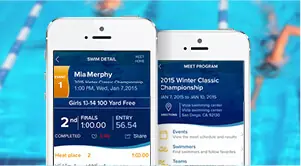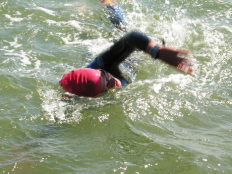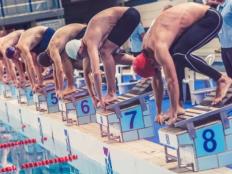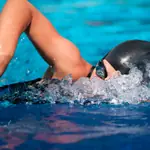While running, you usually have one foot in contact with the ground, providing one less degree of freedom than swimming. Cycling, on the other hand, allows constant contact with the saddle, both hands and both feet, accounting for five fewer degrees of freedom than swimming. In swimming, there are really no solid contact points and plenty of opportunities to create your own problems.
Pool swimmers can be very graceful and fast, but may have difficulty translating this in-pool speed to the open water.
It is the front-end focused swimmers, with a long glide, strong catch and low turnover/cadence, who are most efficient in calm, smooth, non-crowded waters. However, this group is often out swum in the open water by the high turnover crowd as they thrash through the waves with a strong back end to their stroke.
One of the most frustrating challenges for swimmers with poor mechanics is that they may spend countless hours in the pool, swimming hard, but fail to make any significant progress in their open water swim speed. This equates to a misappropriation of the athlete's "stress budget", because a good deal of stress is utilized with little or no return on the investment.
Swimmers have a variety of common problems with their mechanics, including poor balance, missed catch and low cadence. These swim drills will help identify stroke mechanics that may be handy when underwater video analysis is not readily available.
Golf
1 of 14
Use this as a metric to measure streamlining and body balance. The golf test is performed by swimming 50-yards and recording your time, in seconds, and the total number of strokes it takes. Take the sum of these two numbers and that is your score.
Like the sport of golf, the lower the score, the better. A score that is above 65, for taller athletes, and 75, for shorter athletes, is typically indicative of the need for work with balance drill sets to improve streamlining.
Find:
Your Next Triathlon100 No Kick, 50 Kick
2 of 14
This test helps identify propulsive needs. Swim a 100-yard time trial (TT) without kicking at all, followed by a 50-yard TT using a kick board. Then divide your time for the 100 yards by your time for the 50 yards.
If this score is outside of the 1.50 to 1.70 range, then you should either be working more on your kick propulsion or your upper body propulsion (i.e. arm position, catch, pull, follow-through). A ratio that is greater than 1.7 is indicative of relatively weak upper body propulsion. A ratio that is lower than 1.5 may point towards a weaker kick.
Find:
Your Next TriathlonThe TI (Total Immersion) Family of Swim Drills
3 of 14
The following series of swim drills mainly addresses balance and streamlining issues. But, once you fix your balance issues, avoid these drills because they tend to slow swim cadence and increase front end glide.
Find:
Your Next TriathlonFist/Free
4 of 14
If you have: Poor balance, straight arm recovery, cross-over and/or disconnected shoulders and hips.
Swim 100-yards, the first 50-yards with closed fists, and the second 50-yards with open hands. This helps to improve the catch phase of your stroke, by making you very conscious of your arm and hand positions, following the fist lengths.
Find:
Your Next TriathlonAerobic Paddles
5 of 14
If you have: Missed catch.
This helps to improve swimming-specific strength and the catch phase. Using paddles in an aerobic manner, similar to the 50 fist/50 free drill, forces you to become more aware of your hand positions, through the entirety of your stroke.
Find:
Your Next TriathlonAnkle Bands
6 of 14
If you have: Missed catch, weak back end, and/or strength limiters.
Ankle bands shut off a swimmer's kick, forcing them to balance their body in order to create a more productive forward pull. Forward velocity helps create balance and is a function of good mechanics. This swim drill is very effective for most triathletes, as it addresses almost all common deficiencies.
Find:
Your Next TriathlonTabatas
7 of 14
If you have: Any of the above issues.
Tabata intervals are a great tool for improving turnover. Do these once or twice each week by sprinting 25 yards while focusing on high stroke turnover, followed by a 10-second rest, and repeat eight to 10 times. Do two sets with two minutes rest in between.
Find:
Your Next TriathlonSingle Arm Swimming
8 of 14
If you have: Poor timing and/or low swim cadence.
Single arm swimming is the number one way to connect a swimmer's hips to their shoulders. With one arm out in front, stroke with the other arm. Once you master this, hold the arm that is not stroking at your side.
Find:
Your Next TriathlonSwim Cords
9 of 14
If you have: Disconnected shoulders and hips.
Swim cord routines are an excellent way for swimmers to help ingrain good arm position and the elusive high elbow. It is always easier to work on these items with the consistency of dry land, than in the multi-variable environment of the water. Swim cords also help to target potential strength limiters in swimmers with relatively low body mass index (BMI).
Find:
Your Next TriathlonCognitive Thinking
10 of 14
If you have: Missed catch, weak back end, strength limiters.
Believe it or not, cognitive thought can address all of the above issues. All of the drill work in the world is useless if you are not thinking about your swim mechanics with each and every stroke. For example, thinking "fingers tips down, wrist aligned" early in your swim stroke can help to create a higher elbow and faster cadence.
Find:
Your Next TriathlonVertical Kicking and Fin Work
11 of 14
If you have: Poor kick.
For those with very poor kicking ability, vertical kicking in the deep end for 1-minute sets is a great way to generate more kick propulsion from the hips. Do this with a kickboard in your hands, slowly moving it above your head as you progress.
Once you can do three sets of one minute with the board above your head, move onto swimming with the fins, which helps you feel your kick more effectively.
Find:
Your Next TriathlonPull Buoy Swimming
12 of 14
If you have: A 100 No Kick, 50 Kick ratio that is below the 1.50 threshold
Focused aerobic pull buoy swimming is a great way to shut off the kick and allow you to focus on many of the upper-body related limiters identified above. This is especially beneficial for any identifiable body rotation limiters.
Find:
Your Next TriathlonFor Any Issue Other than Poor Balance
13 of 14
If you are looking for an efficient and comfortable way to swim while training and racing, focus on the front end, a low stroke count and long glide. If you want to lead the swim portion of a triathlon, focus on a strong back end and high turnover, both of which still require good balance in the water.
Different swimming objectives require different training techniques and mechanical demands. So, when receiving swim drill advice or looking for a coach, make sure that you clarify the type of racing that you are looking to do, and make sure that the advice matches your specific objectives.
Find:
Your Next TriathlonGet ACTIVE on the Go


Meet Mobile
Swim smarter: heats, lane assignments and real-time results in the palm of your hand.
Available for iOS | Android





Discuss This Article